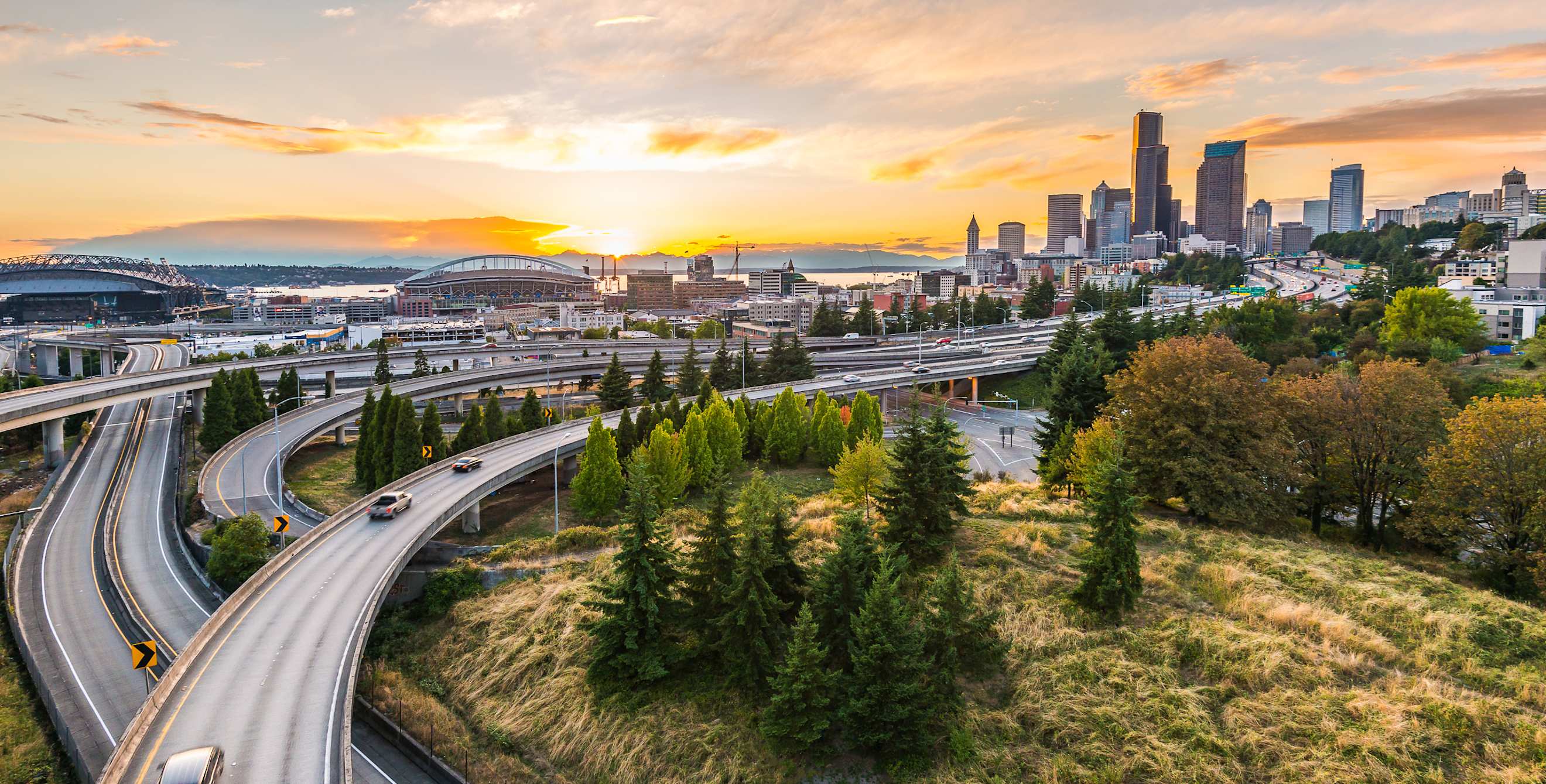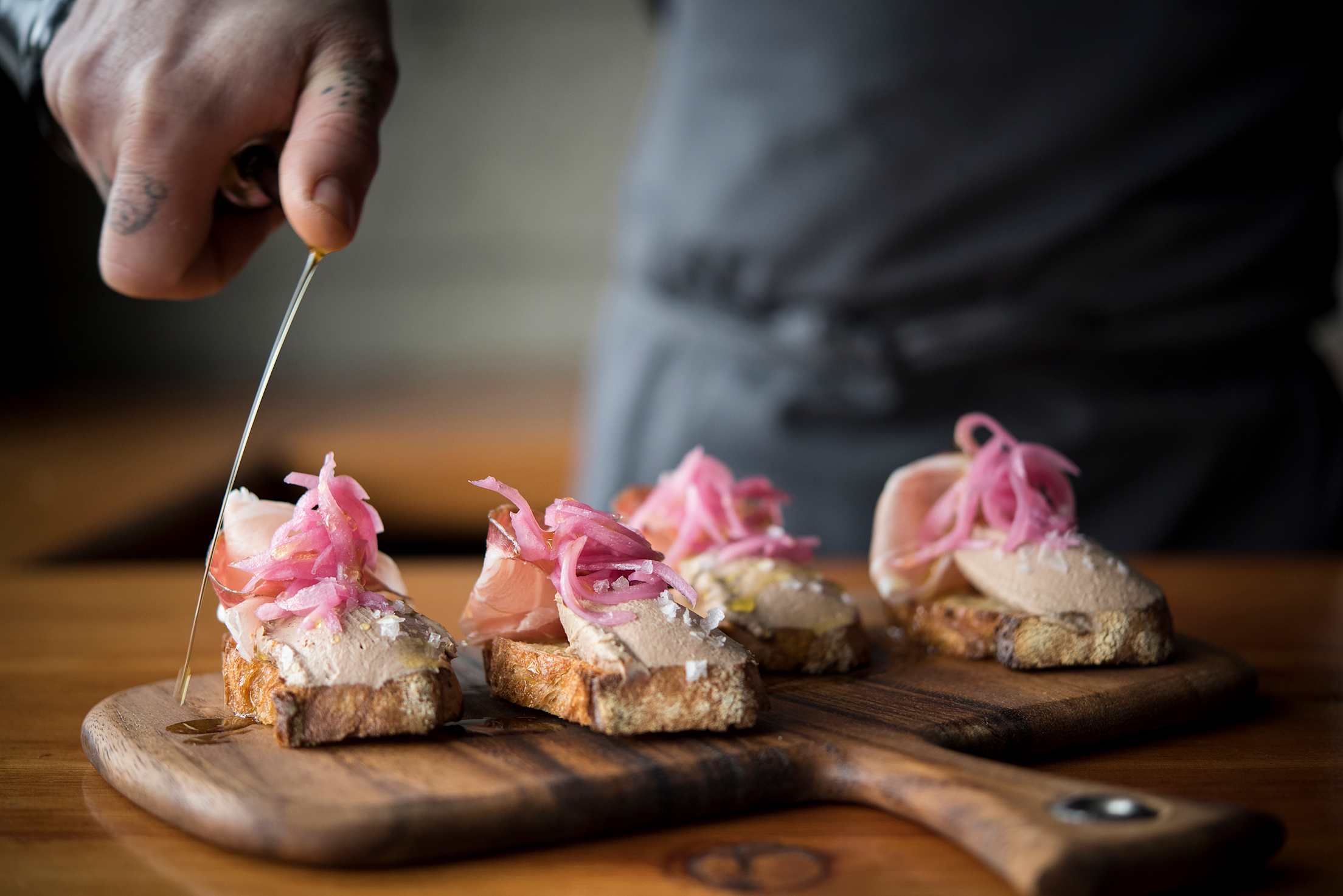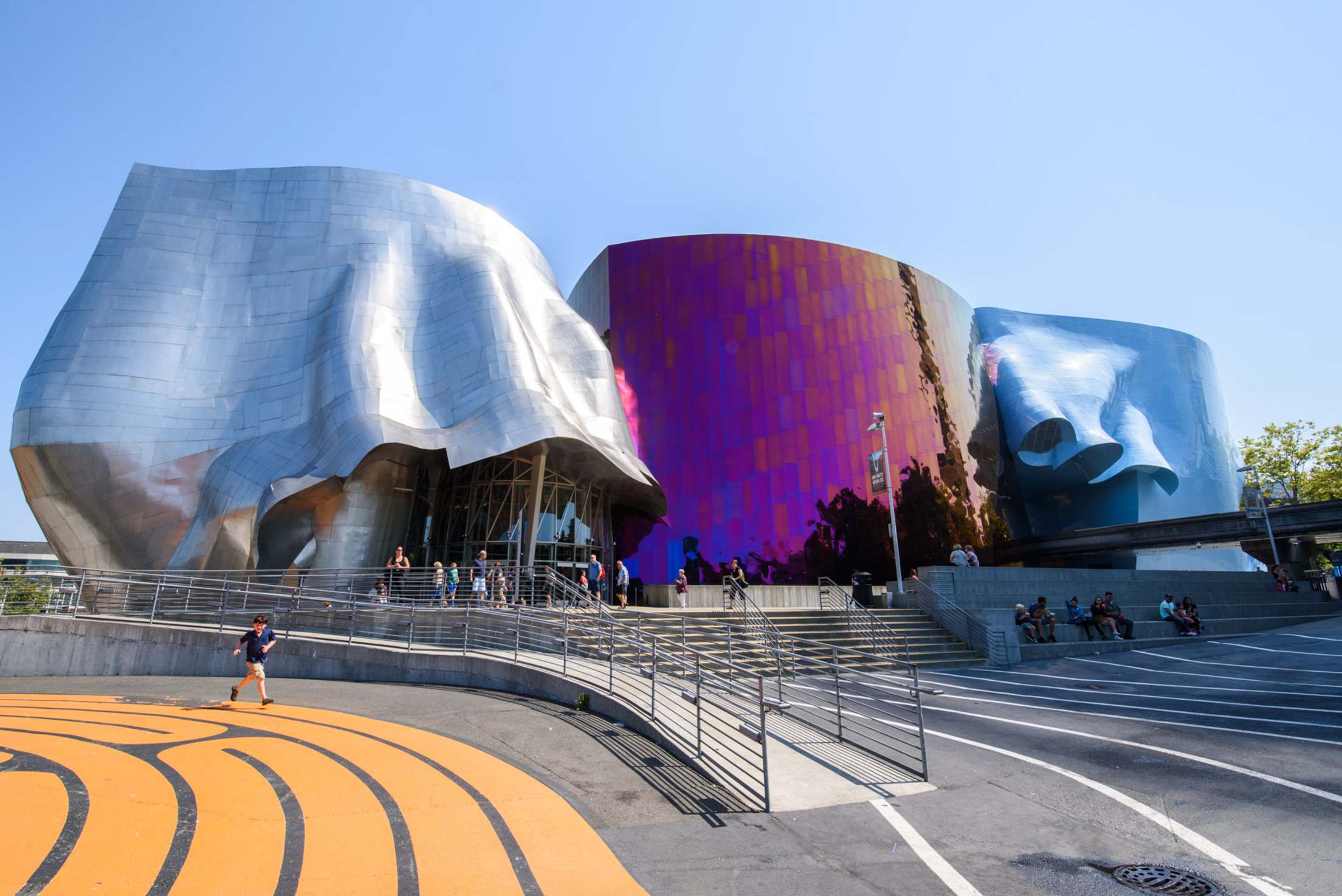
The Rapid Growth of Seattle and Where to Go Now
Seattle's neighborhoods are humming, while favorite attractions enjoy spiffy updates.

I'm on the stick, my daughter is on the triggers. Together, we're flipped upside down in an F-16 flight simulator, deep in a dogfight. Her long blond hair flies everywhere, and blood fills my face.
"We got 'em, E!" I blurt, a virtual bogey in our sights. Alas, we miss: Evie, who is 8, is laughing too hard to engage.
Our family has come to Seattle for a long weekend, and the Museum of Flight is our first stop. Founded in 1965, it's one of the oldest air-and-space museums in the country. But it's an exhibit tracing the history of the Apollo program that brought us here. The star of the show is a Rocketdyne F-1 rocket engine—the most powerful ever flown—that helped propel Apollo 12 to the moon. That piece of aerospace history lay at the bottom of the ocean until Seattle's own Bezos Expeditions raised it from the depths.
They call Seattle "Jet City," but these days it's flying more like one of those rockets. The city is among the country's fastest-growing major urban centers, with plans for more superskyscrapers, a megatunnel, and biospheric domes that are part of Amazon's $4 billion downtown campus. Take one look at the skyline and you'll understand why Seattleites say their official bird should be the crane.
The growth spurt has brought with it a slew of new places to eat and drink. Star chefs such as Josh Henderson and Renee Erickson have opened venues showcasing their inventive takes on Northwest cuisine. Craft breweries like Holy Mountain and Cloudburst experiment with unusual hops to create distinctive beers with award-winning results.
The boom has also given some of the city's tried-and-true attractions a welcome jolt of energy. Most notably, Pike Place Market recently unveiled an additional 12,000 square feet of vendor space, part of a $74 million upgrade. It's the first time the nine-acre hub of fish throwers, buskers, and cheesemongers has expanded in 40 years, and just part of a multiyear, multibillion-dollar project under way to transform Seattle's waterfront. Old roadways and other infrastructure will be replaced with walkways and parks, making the area more people friendly and reclaiming previously blocked views of Puget Sound and the Olympic Mountains beyond.

The city shines as we exit the museum, clouds curling over the horizon like swirls in brushed steel. In search of a seafood lunch, we roll north from the Museum of Flight and enter Columbia City, an up-and-coming neighborhood in a place that's full of them. We pass by Geraldine's Counter, famed for its corned beef sandwiches, and the Royal Room, pulsing with Latin music and jazz. Later, we'll dine on homemade ravioli at Tavolàta in Belltown, then stop at Frankie and Jo's in Capitol Hill for vegan ice cream.
For now we opt for the 100 Pound Clam, the walk-up window sibling of the White Swan Public House in South Lake Union. The two seafood joints share a deck along a small harbor. (The Clam shuts down for the winter, but the White Swan is open year-round.) It's chilly out now. "Pacific Northwesterners have no problem sitting outside when we probably shouldn't," says Mona Tiniakoff, our server.
She brings us Kusshi oysters and "poutine o' the sea," a pile of frîtes dressed in clam-chowder gravy—proof that the universe loves us. We watch a seaplane take off from the lake. A small dinghy tacks across the water, heading back to the Center for Wooden Boats just down the shore. There, adults can take classes in maritime carpentry; kids can build toy boats or go for a 45-minute sail in a real one with a volunteer skipper. My daughter would love to do either. "Next time," I promise.

I make it up to her at the Museum of Pop Culture—MoPop for short—another classic Seattle attraction that has had a recent update. It started out as Paul Allen's Experience Music Project, then went through a series of name changes before settling on MoPop to better reflect the museum's sprawling dedication to music, film, and television. Evie obsesses over the face hugger from Alien, while my wife waxes nostalgic at the wedding gown from The Princess Bride. Workers prepare to lower a huge photograph of Kurt Cobain to make room for a David Bowie exhibition that runs through January. We spend three hours at the museum. By the time we leave, I can play "Werewolves of London" on the keyboard, and Evie can rap.
It's still cool and gray the next day, which is nice in a grounding kind of way. November in Seattle is a time to get cozy, to sink into an indie film at the SIFF Cinema Egyptian movie theater on East Pine Street or sip cappuccino at Storyville at Pike Place. These old haunts ease the slide into a lazy season. As local painter Marlene Seven Bremner puts it, "The sun forgives us for our falling into winter."

The rain has yet to fall, so we make like Northwesterners and bolt outside while we can. We hike around Golden Gardens Park on Shilshole Bay and explore the farmers' market on Ballard Avenue. Open every Sunday, it's one of the best markets of its kind anywhere. We buy kolacky and kombucha and watch a couple make naan. Shops lining the market mix the old, the new, and the just plain wild. Vintage dresses hang in the windows at Lucky Dry Goods. Dandelion Botanical Company sells bladder wrack and peppermint oil. Evie is in heaven at the Ballyhoo Curiosity Shop, a grotesque world of strange taxidermy, plasticized water snakes, and knives carved from jawbones. Her letter to Santa this year is going to be crazy.
The last day, I head to Pike Place on my own for a closer look at the new MarketFront addition, which makes room for 47 vendors, including new locations for favorites such as Old Stove Brewing and Honest Biscuits.
It still feels pretty touristy to me until I meet up with Liz McCune outside Seattle Coffee Works. She assures me that some of the city's best chefs really do shop at the market. She should know: McCune is a Paris-trained chef herself who started Eat Seattle in 2015. In that program, local pro cooks guide visitors in buying ingredients and then crafting three course meals from them.

Pure Food's Sol Amon—flanked by fellow fishmongers Sean Sr., left, and Harry, right—has been selling fish for more than 60 years.
McCune guides me through a series of her favorite stops at the market. We swing by a small terrace where gardeners grow produce for senior citizens on fixed incomes. At Ellenos, the full-fat yogurt with honey is food for the gods. And at Pure Food Fish, I taste a slab of alder-smoked salmon supplied by the "cod father" himself, Sol Amon, one of the market's legendary fishmongers.
I bid McCune good-bye and, passing a ceramic mural of brightly colored sea creatures, walk to the waterfront. I wander down Pier 57 and queue up behind some Seahawks fans for Wings over Washington. It's a new "flying theater"—one of those attractions where the chairs lift and tilt in sync with footage from high-definition cameras, making you feel like you're flying even though you're not. The only bogey this time is a virtual thunderbird that takes us on a tour of the state.
The lights go down. The music comes up. The seats launch into the air, and the room splits with squeals. Soon we are rocketing over whales and around Mount Rainier. We zoom over whitewater rafters and mountain bikers and a festival of hot air balloons. At last, Seattle comes into view, fireworks popping above the skyline. Up and up we go, over a city that's soaring.

Dahlia Bakery's coconut cream pie.
Seattle's Growing Neighborhoods
Seattle comprises a collection of sparkling neighborhoods—and the things that make them great places to live also make them great places to visit. Here are three of the most stroll-worthy.
1. Capitol Hill
Of all the neighborhoods in Seattle, Capitol Hill (east of Lake Union) may be changing the most. Within a few blocks, you can find rock-and-roll pizza joint Sizzle Pie and the contemplative Chapel of St. Ignatius at Seattle University. Seek out Chophouse Row, a pedestrian alley with hip restaurants and offbeat nooks like the Scotch Pine, which is dedicated to the revival of old-school barbering. Another classic: the Volunteer Park Cafe, where neighbors nosh on French toast made with caramelized-banana brioche.
2. Fremont
Artsy, funky, and slightly retro, this community northwest of Lake Union has managed to keep its character despite a building boom around it. Head to Schilling Cider House for 32 ciders on tap. The Fremont Sunday Market is more "flea" than "farmers," with crafts and collectibles (including bins of vinyl records) to sift through. Watch all kinds of vessels glide through the Lake Washington Ship Canal as you stretch your legs along Fremont's portion of the 19-mile Burke-Gilman Trail. Oh, and don't miss the famous Fremont Troll under the Aurora Bridge.
3. Belltown
First developed in the early 1900s, Belltown has had its ups and downs. But what was once a low-rent, semi-industrial district is on the upswing today. The triple coconut cream pies at Dahlia Bakery put Grandma's to shame. And on nice days (Seattle does have them), check out the nine-acre Olympic Sculpture Park on Western Avenue.